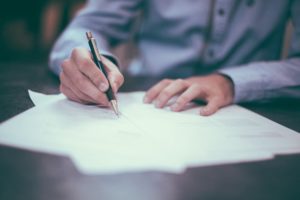Accidents don’t just happen. In most cases, you can trace the cause of the accident back to the negligence of one or more parties. But why does it matter who was at fault? The accident already happened; blaming someone won’t turn back the clock.
While fault may not seem important at the time of the accident, it is everything when it comes time to file a claim. For insurance companies, fault determines who has the right to recover damages and, more importantly for them, which insurance company has to pay. Depending on where you live, if the insurance company finds you at fault, you could receive nothing.
When it comes to your rights, establishing fault is very important and having an experienced attorney can help. But how exactly does an insurance company determine who was at fault?
Four ways insurance companies decide who was at fault
In many cases, determining fault is easy. If one of the drivers was drinking, speeding, or driving recklessly, an investigation will generally confirm that the driver’s actions were negligent. If the two parties agree on fault, the insurance companies often have little room to fight. Where things get tricky is when both parties refuse to accept the blame.
Fortunately, there are many things insurance companies can use to prove liability, including:
Victim statements
When reports dispute what happened, the insurance companies typically can’t go off the victim statements alone. However, just because your statements don’t match up with the other party’s doesn’t mean they don’t hold value.
After an accident, the insurance company will talk to both parties to try to reconstruct what happened. Insurance companies are pretty good at listening to what someone says happened and comparing it to the facts. If a person is lying about what happened during the accident, chances are, they are the ones who hold the blame.
The police report
Most states require drivers to report a car accident if the accident resulted in an injury or death. In California, you must notify the California Highway Patrol immediately following the accident. If the police arrive at the scene, they will take a written report of what happened and talk to witnesses at the scene. This unbiased report can provide details that help determine who was at fault.
Physical evidence
Physical evidence is very hard to dispute after an accident. A picture or video can quickly clear up inconsistent testimony. That makes documenting everything you can after an accident so important. There are several ways you can document the scene. In most cases, your phone’s camera is the easiest way to keep a record.
Some of the best evidence includes:
- Pictures, including vehicle damage and property damage
- Surveillance videos
- Witness testimonies
Accident reconstruction
If the insurance company still can’t determine who was at fault, they may hire an accident reconstruction company. During an accident reconstruction, an expert will examine the evidence to reconstruct what happened. They will examine vehicle damage, property damage, any injuries, and how the accident caused these outcomes.
In many cases, accident reconstruction can show:
- How fast the vehicles were traveling
- Whether a vehicle braked or accelerated before impact
- Which vehicle initiated contact
- The point of impact
- If there were any pre-existing mechanical issues
- If weather played a role in the accident
Looking for a Lawyer?
When it comes to lawyers and seeking your claims you need the best. We offer professional experienced lawyers that can achieve the results you want out of your case. Reach out to us today!
Do you know who holds fault in these scenarios?
There are some cases where the fault is assumed. This is either because of the laws that surround the accident or the basic mechanics of an accident. In these cases, the insurance company will typically assume a given party is at fault unless there is evidence to contradict it. Let’s take a look at a few examples:
Rear-end accidents
A recent report from the Insurance Information Institute showed that rear-end collision accounted for over 7 percent of all fatal accidents over one year. Rear-end accidents happen when the front end of a vehicle collides with the back end of another.
In almost all situations, the insurance company assumes the rear driver was at fault. This is because most states require drivers to keep a safe following distance.
Examples of when you can hold the lead driver at fault include:
- The driver came to a sudden stop for no reason
- The driver was brake-checking the rear driver or trying to get hit
- The driver was going in reverse
- The lead driver’s tail lights were not functioning
Parking lot accidents
Parking lot accidents happen every day. These areas can be heavily congested and often lack appropriate directional signage. One of the most common locations for parking lot accidents is when a vehicle is moving in or out of a parking space. Once again, these types of accidents are usually pretty clear-cut.
The law assumes that the driver moving forward has the right of way. If a collision happens when a driver backs out of a space, the driver leaving the space is usually at fault.
On the other hand, if a driver leaves their space but moves forward through an empty parking space and collides with a vehicle trying to enter, the leaving vehicle is again at fault. This is because the driver will leave through the rear of the space. Therefore, they are technically going the wrong way when they move forward.
Wrong-way accidents
There is rarely a dispute regarding wrong-way accidents. US traffic laws are very clear regarding what side of the road to travel on, what road markings mean, and appropriate passing behavior. When it comes to wrong-way accidents, the wrong-way driver is always assumed to be at fault.
Left-turn accidents
To make a left turn, you must cross at least one lane of oncoming traffic. When making a turn, you always have to yield to oncoming traffic unless you have a green arrow. If the turning vehicle does not have a green arrow, they are generally at fault.
Some exceptions may include:
- The oncoming vehicle was speeding, making it impossible to accurately judge distance.
- The oncoming vehicle turned off headlights during evening hours, making visibility difficult.
If the vehicle turning had a solid green arrow, the likely scenario is that the oncoming vehicle ran a red light and is at fault.
How to protect your interests after an accident
Unfortunately, many accidents turn into arguments of “he-said/she-said.” Never assume the other party will do the right thing. The more you can do to protect your interests, the better off you will be.
After an accident:
- Stay at the scene: Most states have laws regarding leaving the scene of an accident. In California, you must stop at the scene, even if your accident only involves property damage. If you leave without talking to the other driver, you look guilty and forfeit the ability to get the other driver’s insurance information. Meaning, you don’t have a case.
- Don’t apologize and don’t accept blame: For some reason, there’s an instinct to apologize after an accident, even if it is not your fault. Don’t do this. Avoid saying anything that would indicate any blame. While apologizing may seem the right thing to do, the insurance company will use your words against you as an admission of guilt.
- Don’t lie: Once the insurance company finds out you’ve lied, you lose all credibility. They will question everything you say from that point forward. Be truthful. It will only help you in the end.
- Preserve your evidence: One of the most important things you can do to prove the fault is to gather evidence. Don’t skip this step. If you don’t have proof to back up your claim, the case can go either way.
- Go to the doctor: Sometimes, your injuries will provide answers as to what happened. A bruise left by the seatbelt may show how fast the other driver was going. Dizziness may indicate head trauma. It’s best practice to go to the doctor immediately following your accident. This will allow your doctor to document any injuries or symptoms right away.
- Don’t wait to open an accident case: It’s never a good idea to wait too long to open an accident case. Your case may rely on time-sensitive evidence. Video surveillance and witness testimony can provide critical information to prove who was at fault. However, if you wait too long, this evidence may not exist by the time you go to use it.
- Don’t provide a recorded statement to the insurance company: The insurance company is immediately looking for evidence to use against you. If they can get it on record, even better. Do not provide any recorded statements to the insurance company. Instead, direct any communication to your legal representative.
- Work with an experienced personal injury attorney: The simple truth is that insurance companies don’t want to pay out if they can help it. This means the other party’s insurance will look for ways to prove you were at fault. An experienced attorney can help you gather evidence and disprove the insurance company’s claims.
Your right to financial compensation
If the insurance company determines you were not at fault, you may have a case for monetary damages. This can help you cover expenses incurred as a result of the accident. Just as the insurance company will investigate the fault, they will also look at your specific damages and calculate what they believe is a reasonable settlement for your case. You can always counter this amount, and your attorney can help you determine the actual value of your case.
There are many things the insurance company will consider to determine how much your case is worth.
This includes:
- Medical expenses: After an accident, medical bills are often the biggest expense. A visit to the emergency room can easily exceed $10,000. An accident claim can help you recover most, if not all, of your medical costs. This includes office visits, emergency transportation and services, hospital stays, surgeries, medication, and medical devices.
- Lost income: If your injuries make it so you cannot immediately return to work, you may have a right to recover lost wages. Lost wages generally begin the first day you miss due to your injuries and end the day you return. These wages are payable through a lump sum payment after your case. If you cannot return to work at all, you may have a claim for future lost wages.
- Pain and suffering: Accidents can cause tremendous physical and emotional pain. You can’t put a dollar amount on pain, but you can recognize it is something that comes with a cost. Pain and suffering can interfere with your ability to go to work, sleep, or enjoy life. When an accident affects your daily quality of living, your attorney can ask for pain and suffering compensation.
Don’t take the blame after an accident. Stand up for your rights
Insurance companies often establish liability early on. The insurance company will try to use everything you say against you. When someone else’s negligence results in your injuries, you shouldn’t have to be stuck with the bill. An experienced accident attorney can help you prove who was at fault and advocate for a settlement that aligns with the actual value of your case.
Don’t let the insurance company take advantage of you. Stand up for yourself. If an accident injured you or someone you love, contact an experienced attorney for more information about your case.
[/vc_column_text][/vc_column][/vc_row]